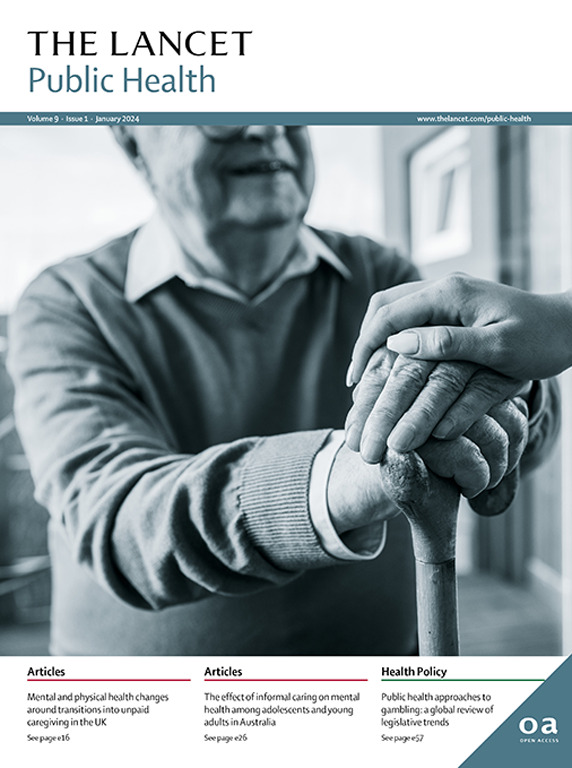估计过渡到基于强度的酒精税制对酒精消费和健康结果的影响:英格兰税制改革模型研究。
IF 25.4
1区 医学
Q1 PUBLIC, ENVIRONMENTAL & OCCUPATIONAL HEALTH
引用次数: 0
摘要
背景提高酒精税额是解决全球酒精危害负担日益加重问题的最有效措施之一。然而,人们对改变酒精税收结构的效果知之甚少。2023 年 8 月颁布的英国酒类税收结构重大改革意味着,所有酒类都将根据其乙醇含量征税,在零售场所(如公共场所)销售的啤酒和苹果酒将减税(以下称 "吃水减免"),啤酒尤其是苹果酒的税率仍低于同等强度的其他酒类。我们的目标是模拟这些改革对酒精消费、健康和经济结果的影响,以及假设的其他方案的影响。方法使用谢菲尔德烟酒政策模型来估计政策对酒精消费的影响。该模型是基于个人的微观模拟,使用的数据来自英格兰健康调查、生活费用和食品调查、医院事件统计以及国家统计局。对干预后 5 年内零售商和政府的支出和收入进行了累计估算。据估计,与不改变政策相比,改革可使每位饮酒者每周的平均饮酒量减少不到 0-05 (-0-34%) 单位(1 单位=8 克/10 毫升乙醇),并在 20 年内防止 2307 人死亡和 11 510 人入院。据估计,取消降温可避免 1441 例死亡和 14 247 例住院。假设情景显示,取消吃水酒减免只会略微改善公共卫生结果,而提高啤酒和苹果酒税率使其与其他同等强度的饮料相匹配,则每周可再减少 2-5 单位的消费量(-17%),死亡人数减少约 74 465 人。然而,英国的改革不太可能大幅改善健康结果,因为它们并没有全面提高税收。提高最低税率的啤酒和苹果酒的税率可大大提高公共健康效益,减少健康不平等现象。本文章由计算机程序翻译,如有差异,请以英文原文为准。
Estimating the effect of transitioning to a strength-based alcohol tax system on alcohol consumption and health outcomes: a modelling study of tax reform in England.
BACKGROUND
Increasing the amount of alcohol taxation is among the most effective measures for addressing the rising global burden of alcohol harm. However, less is known about the effect of changing alcohol tax structures. Substantial reforms to UK alcohol taxation structures enacted in August, 2023, mean that all alcohol is taxed based on its ethanol content, beers and ciders sold in on-trade premises (eg, public houses) are taxed at a reduced rate (hereafter called draught relief), and beer and particularly cider remain taxed at lower rates than other alcohol of equivalent strength. We aimed to model the effect of these reforms on alcohol consumption and health and economic outcomes, and the effects of hypothetical alternative scenarios.
METHODS
The Sheffield Tobacco and Alcohol Policy Model was used to estimate policy effects on alcohol consumption. The model is an individual-based microsimulation that uses data from the Health Survey for England, Living Costs and Food Survey, Hospital Episode Statistics, and the Office for National Statistics. Spending and revenues to retailers and the Government were estimated cumulatively for a 5-year period post-intervention. Policy effects on all-cause deaths, years of life lost, hospital admissions, and admissions costs were estimated cumulatively for a 20-year period post-intervention.
FINDINGS
The reform was estimated to decrease mean weekly alcohol consumption per drinker by less than 0·05 (-0·34%) units (1 unit=8 g/10 mL ethanol), and prevent 2307 deaths and 11 510 hospital admissions during 20 years compared with no policy change. Removing draught relief was estimated to prevent 1441 further deaths and 14 247 further admissions. Hypothetical scenarios showed that removing draught relief would only slightly improve public health outcomes, and increasing tax rates for beer and ciders to match other drinks of equivalent strength would reduce consumption by a further 2·5 units per week (-17%) and deaths by approximately 74 465.
INTERPRETATION
Alcohol tax structures based on alcohol strength enable tax policy to improve public health in a targeted way. However, the UK reforms are unlikely to substantially improve health outcomes as they do not raise taxes overall. Raising tax rates for the lowest taxed beer and ciders, which are favoured by those who consume harmful amounts of alcohol, could achieve substantially greater public health benefits and reduce health inequalities.
FUNDING
National Institute for Health and Care Research and UK Prevention Research Partnership.
求助全文
通过发布文献求助,成功后即可免费获取论文全文。
去求助
来源期刊

Lancet Public Health
Medicine-Public Health, Environmental and Occupational Health
CiteScore
55.60
自引率
0.80%
发文量
305
审稿时长
8 weeks
期刊介绍:
The Lancet Public Health is committed to tackling the most pressing issues across all aspects of public health. We have a strong commitment to using science to improve health equity and social justice. In line with the values and vision of The Lancet, we take a broad and inclusive approach to public health and are interested in interdisciplinary research.
We publish a range of content types that can advance public health policies and outcomes. These include Articles, Review, Comment, and Correspondence. Learn more about the types of papers we publish.
 求助内容:
求助内容: 应助结果提醒方式:
应助结果提醒方式:


